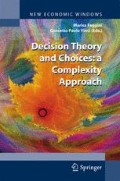Abstract
We propose to describe the acquistion of information by the methods of chemical kinetics, with information and knowledge likened to concentrations of chemical species. The Verhulst-like model proposed is characterized by a limiting knowledge which is specific for a given student. The assumption that time and amount of knowledge are continuous variables is more questionable than in chemical kinetics. Consideration of discrete time intervals lead to a quadratic map, showing bifurcation and chaos. The case of two interacting students is also briefly considered. The examples presented show that manageable teaching should be performed at a sufficiently small rate.
Access this chapter
Tax calculation will be finalised at checkout
Purchases are for personal use only
Preview
Unable to display preview. Download preview PDF.
References
Anderson LW, Krathwohl DR (2001), A taxonomy for learning, teaching and assessing: A revision of Bloom’s Taxonomy of educational objectives: Complete edition, Longman, New York
Bailey CH, Kandel ER (2008) Progress in brain research 169:179–98
Bloom BS, Krathwohl DR (1956) Taxonomy of educational objectives: The classification of educational goals, by a committee of college and university examiners. Handbook 1: Cognitive domain, Longmans, New York
Braitenberg V, Schüz A (1998) Cortex: Statistic and Geometry of Neuronal Connectivity (2nd ed.), Springer-Verlag, New York
Dobrossy MD, Drapeau E, Aurousseau C, Le Moal M, Piazza PV, et al. (2003) Mol Psychiatry 8: 974–982
Gross D, Strand R (2000) Complexity 5:26–31
R.M. May (1976). “Simple mathematical models with very complicated dynamics”. Nature 261:459. doi:10.1038/261459a0
Miller GA (1956). The magical number seven, plus or minus two: Some limits on our capacity for processing information. Psychological Review, 63:81–97
Monaco G (2008) Sulla possibilità di sviluppare modelli di apprendimento basati su agenti. In: Abbona F, Del Re G, Monaco G (eds) Complessità dinamica dei processi educativi. Aspetti teorici e pratici. FrancoAngeli, Milano. ISBN: 9788856805543
Sun R (2007) Cognitive social simulation incorporating cognitive architectures. IEEE Intelligent Systems, 22(5):33–39
Tang Y, Nyengaard JR, De Groot DM, Gundersen HJ (2001) Total regional and global number of synapses in the human brain neocortex. Synapse 41(3):258–73
Woessmann L (2006) The Complementarity of Central Exams and School Autonomy: Economic Theory and International Evidence, In: Gori E, Vidoni D, Hanushek E, Glenn C (eds.): Institutional Models in Education: Legal Framework and Methodological Aspects for a New Approach to the problem of School Governance. Wolf Legal Publishers, Nijmegen
Author information
Authors and Affiliations
Editor information
Editors and Affiliations
Rights and permissions
Copyright information
© 2010 Springer-Verlag Italia
About this paper
Cite this paper
Monaco, G. (2010). From Chemical Kinetics to Models of Acquisition of Information: On the Importance of the Rate of Acquisition of Information. In: Faggini, M., Vinci, C.P. (eds) Decision Theory and Choices: a Complexity Approach. New Economic Windows. Springer, Milano. https://doi.org/10.1007/978-88-470-1778-8_9
Download citation
DOI: https://doi.org/10.1007/978-88-470-1778-8_9
Publisher Name: Springer, Milano
Print ISBN: 978-88-470-1777-1
Online ISBN: 978-88-470-1778-8
eBook Packages: Mathematics and StatisticsMathematics and Statistics (R0)

